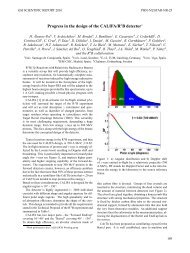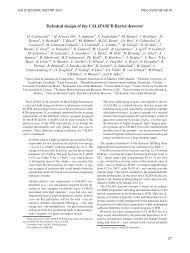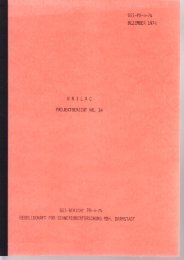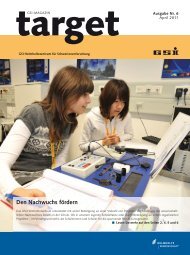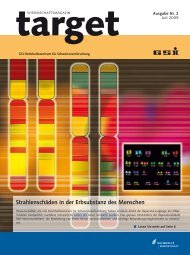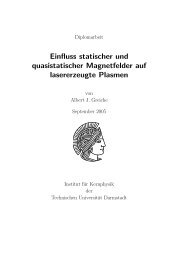download block - GSI Helmholtzzentrum für Schwerionenforschung
download block - GSI Helmholtzzentrum für Schwerionenforschung
download block - GSI Helmholtzzentrum für Schwerionenforschung
Create successful ePaper yourself
Turn your PDF publications into a flip-book with our unique Google optimized e-Paper software.
NUSTAR-SHE-03 <strong>GSI</strong> SCIENTIFIC REPORT 2009<br />
172<br />
<strong>GSI</strong>Template2007<br />
σ / nbarn<br />
Cross-sections for production of neutron deficient Sg - isotopes in reactions<br />
54 Cr + 206,207,208 Pb<br />
F.P. Heßberger 1,2 , S. Antalic 3 , B. Streicher 1,4 , B. Sulignano 5,1 , D. Ackermann 1 , M. Block 1 , S. Heinz 1 ,<br />
S. Hofmann 1,6 , J. Khuyagbaatar 1 , B. Kindler 1 , I. Kojouharov 1 , B. Lommel 1 , R. Mann 1<br />
1 <strong>GSI</strong>-<strong>Helmholtzzentrum</strong> <strong>für</strong> <strong>Schwerionenforschung</strong>, Darmstadt, Germany; 2 Helmholtz - Institut Mainz, Mainz, Germany,<br />
3 Comenius University Bratislava, Bratislava, Slovakia , 4 University of Groningen, The Netherlands, 5 CEA Saclay,<br />
Gif-sur-Yvette, France, 6 Goethe-Universität Frankfurt, Frankfurt, Germany<br />
Due to low cross-sections for the production of heaviest<br />
nuclei the choice of the optimum reaction for specific<br />
nuclides is crucial for nuclear structure investigations<br />
based on α-γ-decay spectroscopy, which demand maximum<br />
numbers of observed events. Following previous<br />
decay studies of 255 No [1] and 257 Rf [2] an experiment to<br />
investigate 259 Sg, the next heavier N=153 isotone, for<br />
which only rough decay properties were known so far [3],<br />
was performed at SHIP in March 2009. The most efficient<br />
way to produce neutron deficient isotopes of seaborgium<br />
is employing reactions of 54 Cr with Pb - isotopes. Excitation<br />
functions for 54 Cr + 208 Pb [2] and 207 Pb [4] had been<br />
measured previously. The results are displayed in fig. 1.<br />
1<br />
0,1<br />
0,01<br />
10 12 14 16 18 20 22 24 26 28 30 32<br />
E* / MeV<br />
Figure 1: Excitation functions for the reactions<br />
208 Pb( 54 Cr,xn) 262-x Sg (blue symbols), 207 Pb( 54 Cr,xn) 261-x Sg<br />
(red symbols),<br />
206 Pb( 54 Cr,xn) 260-x Sg (wine symbols)<br />
(x=1,2). The full symbols represent the 1n - channels, the<br />
open symbols the 2n - channels. The lines represent the<br />
results of HIVAP calculations (full line = 1n channel,<br />
dashed line = 2n channel) for the corresponding systems.<br />
The arrows denote the positions of the Bass model fusion<br />
barriers [5] for the respective target - projectile combinations.<br />
HIVAP [6] calculations using parameterisations to reproduce<br />
the 1n and 2n cross-sections for the reaction 54 Cr +<br />
208 Pb were performed. Evidently this parameterisation<br />
satisfactorily reproduces also the 2n cross-sections for<br />
54 Cr + 207 Pb, while the 1n cross-section is underpredicted<br />
by roughly a factor of two. Going from 207 Pb to 206 Pb<br />
HIVAP predicts a decrease by roughly factors of 2.5 and<br />
4 for the 1n and 2n cross-sections, respectively, and in<br />
addition a shift of the excitation energy for the 1n cross-<br />
section maximum by ≈1.5 MeV towards higher values.<br />
Since the thus expected cross-section of ≈150 pb for<br />
259 Sg is only about a factor of two lower than the measured<br />
value for the reaction 207 Pb( 54 Cr,2n) 259 Sg and an astonishing<br />
high cross-section of ≈320 pb was obtained for<br />
the reaction 208 Pb( 54 Cr,1n) 259 Sg [7] it seemed valuable to<br />
test the reaction 206 Pb( 54 Cr,1n) 259 Sg as an alternative way<br />
of production. The result is shown in fig. 1 (wine symbols).<br />
A cross-section of ≈1 nb was measured for 259 Sg,<br />
which is even about 50% higher than the 1n cross-section<br />
using the more neutron rich target isotope 207 Pb. Differences<br />
of the 2n cross-section are less dramatic. One data<br />
point, close to the expected [6] maximum was taken. We<br />
obtained σ(2n) = 0.14±0.04 nb at E * = 22.5 MeV, which<br />
is roughly a factor of two higher than the predicted value<br />
and a factor of two lower than the 2n cross-section for the<br />
reaction 54 Cr + 207 Pb. This more 'regular' behavior does<br />
not suggest an enhanced stability of 259 Sg against prompt<br />
fission during the deexcitation process. The production<br />
ratios σ( 260 Sg,2n) / σ( 259 Sg,2n) ≈ 1.7 and σ( 260 Sg,1n) /<br />
σ( 259 Sg,1n) ≈ 0.6 do also not suggest a reduction of the<br />
SHIP transmission for 260 Sg due to a short-lived isomeric<br />
state decaying during the separation process. It rather<br />
hints at a strong nuclear structure influence of the target<br />
nucleus on the fusion probability at energies far below the<br />
fusion barrier, established at E * = 23.2±0.5 MeV for the<br />
three systems. More detailed measurements of excitation<br />
functions will show if this is just a local effect connected<br />
with the specific projectile or a more general phenomenon.<br />
In the latter case, only slightly decreasing 1n crosssections<br />
going from 208 Pb to the lighter isotopes 206 Pb or<br />
even 204 Pb, would not only give new insight into the process<br />
of 'cold' fusion, but also enhance our chances of continuing<br />
our program on detailed nuclear structure investigations<br />
of nuclei in the vicinity of the N = 152 subshell<br />
towards isotopes of elements above seaborgium (Z=106).<br />
References<br />
[1] F.P. Heßberger et al., EPJ A 29, 165 (2006)<br />
[2] B. Streicher, PHD, Comenius University Bratislava,<br />
2006, and to be published<br />
[3] F.P. Heßberger et al. EPJ A 41, 145 (2009)<br />
[4] B. Sulignano, PHD, Johannes-Gutenberg Universität<br />
Mainz, 2007<br />
[5] R. Bass, Nucl. Phys. A 231, 45 (1974)<br />
[6] W. Reisdorf, Z. Phys. A 300, 227 (1981)<br />
[7] C.M. Folden III et al. Phys. Rev. C 79, 027602 (2009)





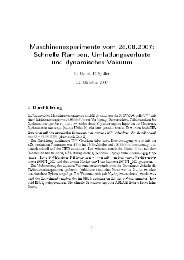
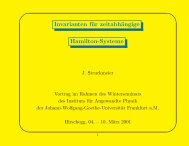
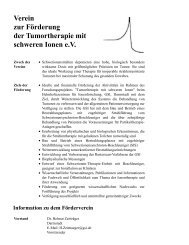
![GS I -P-]-17 - GSI Helmholtzzentrum für Schwerionenforschung](https://img.yumpu.com/20698964/1/184x260/gs-i-p-17-gsi-helmholtzzentrum-fur-schwerionenforschung.jpg?quality=85)

